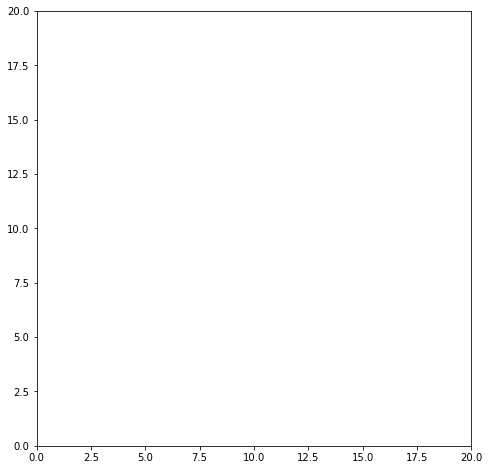8 Dec 2022 - The Ising Model
8 Dec 2022 - The Ising Model#
\[E = -J\left(\vec{S}_i\cdot\vec{S}_j\right)\]
import numpy as np
import matplotlib.pyplot as plt
import random as random
cellLength = 20
simulationSteps = 1000000
couplingConstant = 1.0 ## J
temperature = 1.0
def calculateEnergy(spinArray):
'''Calculate all the pairwise energy interactions and sum them up
Do rows and columns separately and add them up.'''
rowNeighborInteractionEnergy = np.sum(spinArray[0:cellLength-1,:]*spinArray[1:cellLength,:])
columnNeighborInteractionEnergy = np.sum(spinArray[:,0:cellLength-1]*spinArray[:,1:cellLength])
totalInteractionEnergy = rowNeighborInteractionEnergy+columnNeighborInteractionEnergy
return -couplingConstant*totalInteractionEnergy
## Create an empty square array
spinArray = np.empty([cellLength,cellLength], int)
## Populate it with random spins
for row in range(cellLength):
for column in range(cellLength):
if random.random()<0.5:
spinArray[row,column] = +1
else:
spinArray[row,column] = -1
# Calculate the initial energy and magnetization
energyAtStep = calculateEnergy(spinArray)
magnetizationAtStep = np.sum(spinArray)
## Show the spin array
## Black is spin up and white is spin down
plt.figure(figsize=(8,8))
c = plt.pcolor(spinArray, cmap='Greys')
plt.axis('square')
(0.0, 20.0, 0.0, 20.0)

## Hold onto the values of the magnetization
## for each step in the simulation
magnetizationArray = np.zeros(simulationSteps)
## Monte Carlo Loop
for step in range(simulationSteps):
## Store the magnetization at this step
magnetizationArray[step] = magnetizationAtStep
## Store the energy before swapping the spin randomly
oldEnergy = energyAtStep
## Select a spin from the cell
ithSpin = random.randrange(cellLength)
jthSpin = random.randrange(cellLength)
## Flip the spin of that one site
spinArray[ithSpin,jthSpin] = -spinArray[ithSpin,jthSpin]
## Calculate the energy after that change
energyAtStep = calculateEnergy(spinArray)
deltaE = energyAtStep - oldEnergy
## If the change resulted in an increase in the total energy,
## evaluate whether to accept the value or not
if deltaE > 0.0:
probabilityOfFlip = np.exp(-deltaE/temperature)
## If the the random value is lower than the probability,
## reverse the change to the spin, and recalculate the energy
if random.random()>probabilityOfFlip:
spinArray[ithSpin,jthSpin] = -spinArray[ithSpin,jthSpin]
energyAtStep = oldEnergy
continue
magnetizationAtStep = np.sum(spinArray)
plt.figure(figsize=(8,8));
c = plt.pcolor(spinArray, cmap='Greys');
plt.axis('square');

plt.figure(figsize=(8,6))
plt.plot(magnetizationArray)
plt.ylabel('Magnetization')
plt.xlabel('Simulation Steps')
Text(0.5, 0, 'Simulation Steps')




